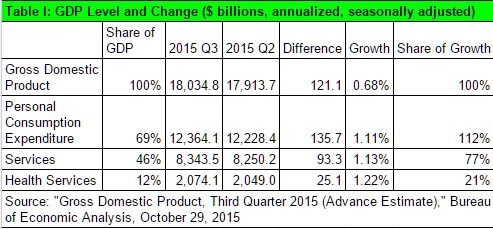Health Services Accounts For One-Fifth Of Weak US Q3 GDP Growth – OpEd
Wednesday’s advance estimate of Gross Domestic Product for the third quarter indicates that growth in health spending is maintaining a disproportionate share of weak GDP growth. Commenters noted that the weak estimate was largely due to shrinking inventories. This explains why personal consumption expenditure (PCE) growth ($135.7 billion) was actually higher than GDP growth ($121.1 billion), quarter on quarter (Table I, below).
Nevertheless, spending on health services grew faster (1.22 percent) than spending on all services (1.13 percent) or PCE (1.11 percent.) The growth in health services spending ($25.1 billion) accounted for one-fifth of all GDP growth.
Looking at the change over one year, from 2014 Q3 to 2015 Q3, health services spending seems to be more under control (Table II). However, it still grew faster (1.54 percent) than spending on all services (1.27 percent) or PCE (1.15 percent). This means that health services spending continues to devour more of our budgets.
Technical note: When I discuss health services in these quarterly GDP releases, I mean only health services. I do not include purchases of medical equipment, or facilities construction. While I include Medicare and Medicaid, I do not include Veterans Health Administration or other government benefits. So, these dollar figures undercount the amount of our economy consumed by the government-health complex.
(See: Measuring the Economy: A Primer on the GDP and the National Income and Product Accounts, Bureau of Economic Analysis, October 2014, pages 5-2 and 5-3; Micah B. Hartman, et al., “A Reconciliation of Health Care Expenditures in the National Health Expenditures Accounts and in Gross Domestic Product,” Research Spotlight, Survey of Current Business, September 2010, pages 42-52.)

This article appeared at The Beacon.

